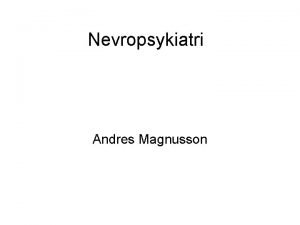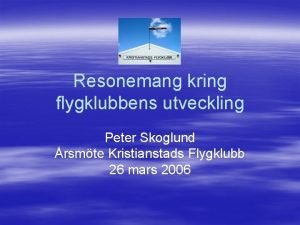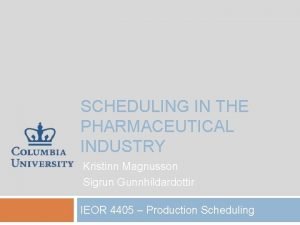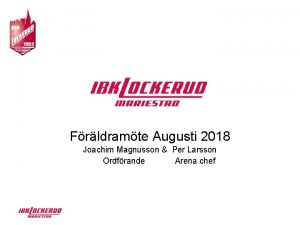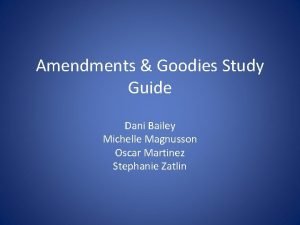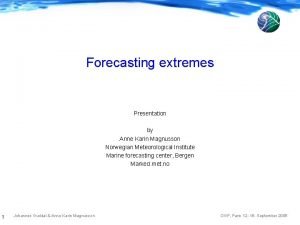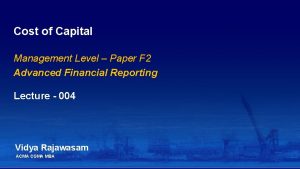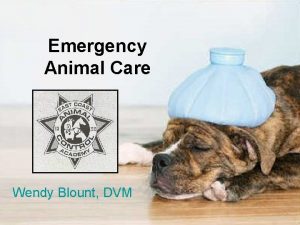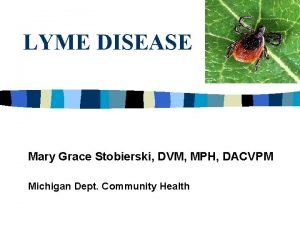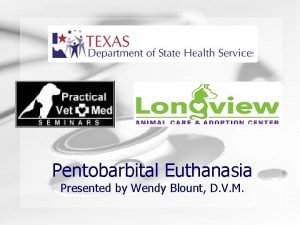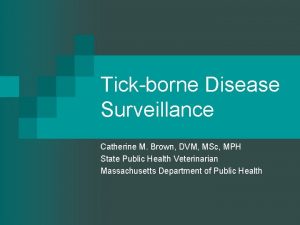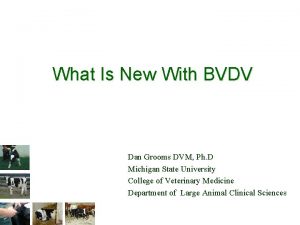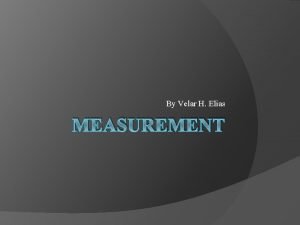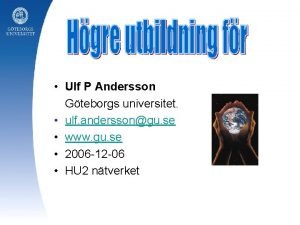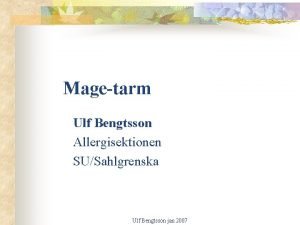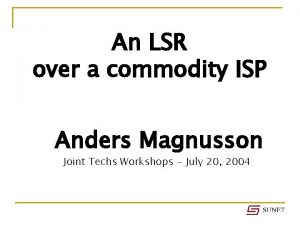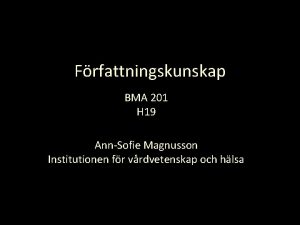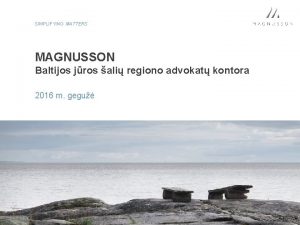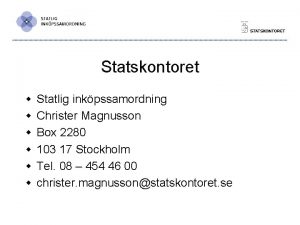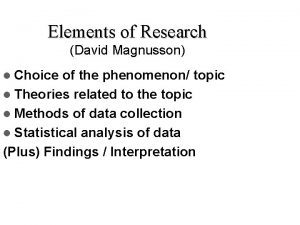Professor Ulf Magnusson DVM Ph D Department of
















- Slides: 16

Professor Ulf Magnusson*, DVM, Ph. D Department of Clinical Sciences and SLU Global Swedish University of Agricultural Sciences, SLU (*public funded only) ANTIMICROBIAL RESISTANCE AND ANIMAL AND HUMAN HEALTH – A ONE HEALTH TASK Panama, 20 -23 June 2016

The One Health dimension of Antimicrobial resistance (AMR) Human health A One World issue as well! AMR Environment health Sixth Multi-stakeholder Partnership (MSP) meeting Panama 20 -23 June 2016 Animal health

Animal health – the entry point Animal health • Productivity - Income, Food security - Natural resource use efficiency, GHG-emissions • Ethics/Animal Welfare • Public health Sixth Multi-stakeholder Partnership (MSP) meeting Panama 20 -23 June 2016

Animal health – the elements Animal health Genetics Feed Management, incl. use of antimicrobials Sixth Multi-stakeholder Partnership (MSP) meeting Panama 20 -23 June 2016 Antimicrobials • antibiotics • antivirals • antiparasitics • fungicides

The emerging issue of resistance to antimicrobials (AMR) The threat to human health and global actions taken: o 10 M deaths and a cumulative economic output of 100 trillion USD at risk by 2050 (O’Neil, 2016) o In 2015, resolutions/action plans by WHO, FAO and OIE o AMR-session at 71 st Session of the UN General Assembly – September 2016 Sixth Multi-stakeholder Partnership (MSP) meeting Panama 20 -23 June 2016

The AMR network and the livestock sector • A shared, crosssectorial, responsibility to take action • Relative importance of the different routes unclear Source: P. Huey (Science) Sixth Multi-stakeholder Partnership (MSP) meeting Panama 20 -23 June 2016

The link between Antimicrobial use and AMR In livestock: Note, this is also true for the human health sector Chantziaras et al. 2014 O’Neil, 2015 Sixth Multi-stakeholder Partnership (MSP) meeting Panama 20 -23 June 2016

The use of Antimicrobials o USA: about 70% of antimicrobials are used in the livestock sector (FDA , 2012) o Sweden: about 15% of antimicrobials are used in the livestock sector (SVA, 2013) o Global estimate : more then 50%are used in the sector Global use of antimicrobials in livestock Sixth Multi-stakeholder Partnership (MSP) meeting Panama 20 -23 June 2016 Van Boeckel et al. 2015

Antimicrobial use in the livestock sector • Estimated to double by 2030 in the BRICS countries (Brazil, Russia, India, China and South Africa) • Most use in intensified pig and chicken operations • Global data about use and resistance are weak Sixth Multi-stakeholder Partnership (MSP) meeting Panama 20 -23 June 2016

What are the options for the future? o New antimicrobials? o Mitigate the emergence of AMR? Ø Reduce the use of antimicrobials Regulations are not sufficient! Sixth Multi-stakeholder Partnership (MSP) meeting Panama 20 -23 June 2016 Sales of veterinary antimicrobial agents in 26 EU/EEA countries in 2013, Fifth ESVAC report

How to reduce the use of antimicrobials in the livestock sector? Animal health Stop the non-rational use of Antimicrobials Genetics Feed Management, incl. use of antimicrobials u use without proper diagnosis and/or indication; u use without adequate dosing and length of treatment; u use for growth promotion and prophylaxis; u routine treatment of herds instead of individuals Sixth Multi-stakeholder Partnership (MSP) meeting Panama 20 -23 June 2016

To stop the non-rational use of antimicrobials o Good animal health management • • • Treatment just after proper diagnosis and/or indication Correct dosing and length of treatment Treat individuals rather than herds Don’t use antimicrobials as growth promoters or routine prophylaxis Improve biosecurity procedures and sanitation/hygiene Stocking densities and facilities/buildings More vaccines Vector control Antimicrobials should ……. not be used for compensating poor livestock management Sixth Multi-stakeholder Partnership (MSP) meeting Panama 20 -23 June 2016

Reducing AM-use without loosing productivity 50 Individual treatment Group treatment 40 mg per PCU o Sweden banned AM as growth promoters 1986 (on demand from Swedish farmers) o Drop in productivity but recovery within a few years o Compensated with good animal health management o Now lowest AMR in the EU o Other EU-countries have followed, without loosing much in productivity 30 20 10 0 808284868889909192939495969798990001020304050607080910111213 Sales of antimicrobials for farm animals, Sweden Sixth Multi-stakeholder Partnership (MSP) meeting Panama 20 -23 June 2016 Swedres-Svarm, 2013

The incentives and financing…. “Tragedy of the commons” Negative externalities Regulations/policies incl. taxation and subsides AMR Consumer’s demands and the market Increased productivity…. Public goods Sixth Multi-stakeholder Partnership (MSP) meeting Panama 20 -23 June 2016

The Global Context – High, Middle and Low-income countries o Differences in productivity in current livestock systems o Differences in animal health technical capacity o Differences in policies and capacity in enforcing policies SOFA, 2009 o Differences in financial resources ………. . and a large knowledge deficit about the Global Situation Sixth Multi-stakeholder Partnership (MSP) meeting Panama 20 -23 June 2016

Gracias! Acknowledgements: Dr. Timothy Robinson, International Livestock Research Institute, Nairobi Dr. Christina Greko, National Veterinary Institute, Uppsala Sixth Multi-stakeholder Partnership (MSP) meeting Panama 20 -23 June 2016
 Andres magnusson
Andres magnusson Bo magnusson pilot kristianstad
Bo magnusson pilot kristianstad Michelle magnusson
Michelle magnusson Joachim magnusson mariestad
Joachim magnusson mariestad Michelle magnusson
Michelle magnusson Karin magnusson
Karin magnusson Promotion from associate professor to professor
Promotion from associate professor to professor Dvm valuation method
Dvm valuation method Wendy blount dvm
Wendy blount dvm Lyme disease map 2020
Lyme disease map 2020 Medial saphenous vein cat
Medial saphenous vein cat Catherine brown dvm
Catherine brown dvm Roger clemmons dvm
Roger clemmons dvm Integrating type dvm
Integrating type dvm Cistache
Cistache Roger clemmons dvm
Roger clemmons dvm Sap business one support launchpad
Sap business one support launchpad
